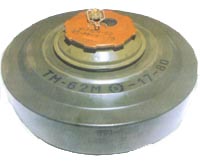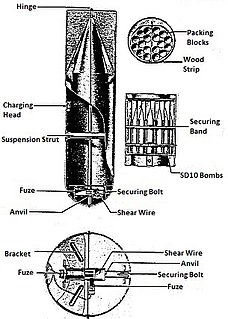Type 72 Non-Metallic is a Chinese circular, plastic bodied landmine which is designed to damage or destroy a vehicle by blast effect.

The Type 11 70 mm infantry mortar, was a muzzle-loading, rifled bore infantry mortar used by the Japanese. The Type 11 designation was given to this gun as it was accepted in the 11th year of Emperor Taishō's reign (1922). It was first used in 1922 and was the first mortar to be introduced by the Imperial Japanese Army. The mortar was later replaced by the Type 92 battalion gun.
The MON-90 is a claymore shaped, plastic bodied, directional type of anti-personnel mine designed and manufactured in the Soviet Union. It is designed to wound or kill by fragmentation. The mine is similar in appearance to the MON-50, but is approximately twice the size with a much greater depth.

The MON-100 is a circular, sheet metal bodied, directional type of anti-personnel mine designed and manufactured in the early 1960s by the Soviet Union. It is designed to wound or kill by fragmentation and resembles a large bowl.

The Tellermine 42 (T.Mi.42) was a German metal-cased anti-tank blast mine used during the Second World War. The mine was a development of the Tellermine 35 with improved resistance to blast. It was followed by the simplified Tellermine 43.
The MON-200 is a directional type anti-personnel mine designed and manufactured in Soviet Union. It is an enlarged version of the MON-100 mine.

The National Development Complex (NDC) is a Pakistani defence and aerospace contractor and a division under the National Engineering and Scientific Commission (NESCOM). Founded in 1990 at the MoD, the NDC engaged in research and development in space-based missile systems and expanded its services towards developing the land-based weapons systems for the army as well as naval systems for the navy.

The TM-46 mine is a large, circular, metal-cased Soviet anti-tank mine. It uses either a pressure fuze or tilt-rod, which is screwed into the top. Anti-tank mines with this type of fuze were capable of inflicting much more damage to armored vehicles. The TMN-46 is a variant of the mine fitted with a secondary fuze well on the bottom which is slightly off-set from the centre of the mine. This secondary fuze well can be fitted with a pull-fuze which functions as an anti-handling device. The mine was used by the North Vietnamese forces during the Vietnam War, and is found in many countries in Africa, the Middle East and South East Asia.
The M7 is a small, metal-cased United States anti-tank blast mine that was used during the Second World War. It was based on the British Hawkins grenade. Approximately 2.5 million were produced before production ceased, and although it has long since been withdrawn from U.S. service, it can be found in Angola, Burma, Cambodia, Chad, Eritrea, Ethiopia, Korea, Lebanon, Myanmar, Somalia, Thailand, and Zambia.

TM-62 is the designation for a series of Soviet anti-tank blast mines. The mines have a central fuze and typically have a 7.5 kg explosive charge, however they vary greatly in detail. The mines can be laid manually or automatically from a mine laying machine including the PMR-1, PMR-2 wheeled towed mine layers, the GMZ tracked mine laying vehicle and the VMR-2 helicopter mine laying system.
The AUPS is a circular Italian bakelite cased minimum metal anti-personnel blast mine. The mine can be adapted with a steel fragmentation jacket and stake into a fragmentation stake mine. The mine is constructed in two halves, with the upper half containing the pressure fuse mechanism, the lower half contains the main charge and the detonator. The mine case is normally unpainted bakelite brown.
The Cardoen EC-2 mine is a Chilean directional fragmentation anti-personnel mine. It is broadly similar to the United States M18 Claymore mine.
The MMN-1 is a small Georgian Claymore type directional anti-personnel fragmentation mine. The mine projects fragments in a sixty degree horizontal arc to a casualty radius of 15 meters.
The MMN-2 is a Georgian Claymore type directional anti-personnel fragmentation mine. The mine projects fragments in a forty-five degree horizontal arc to a casualty radius of forty meters.
The Imperial Japanese Navy Technical Department was the externally operating division of the Ministry of the Navy of Japan responsible for the administration of naval vessel construction. From 1923 onward, it took on the role of a research institution for the research and development of naval technologies and engineering. This included studying and investigating existing western naval technology, developing and overseeing Japan's domestic shipbuilding and arms industries, and training officers to become naval engineers and inspectors. The bureau was dismantled along with the naval ministry in November 1945 after Japan surrendered to the Allies at the end of World War II.

The TMRP-6 is a former Yugoslavian anti tank EFP mine.

The Mahindra Mine Protected Vehicle-I (MPV-I), is an Indian MRAP-type armored personnel carrier manufactured by Defense Land Systems, a joint-venture of Mahindra & Mahindra Limited and BAE Systems, the first vehicle made under the venture. It is an improved Casspir variant built under licence.

Dongfeng Mengshi is a family of off-road 4×4 vehicle developed by Dongfeng Motor Group. Early generations of the vehicle are license-built Hummer H1, while later generations of the vehicles are of indigenous design. Dongfeng Fengshi generally follows the trend of American military requirements. For example, CSK-141 is the Chinese equivalent of armor-plated reinforced Humvee while CSK-181 is the Chinese equivalent of Joint Light Tactical Vehicle.

The AB 250-2(Abwurfbehälter) was a cluster bomb used by the Luftwaffe during World War II.

The AB 500-1(Abwurfbehälter) was a cluster bomb used by the Luftwaffe during World War II.











